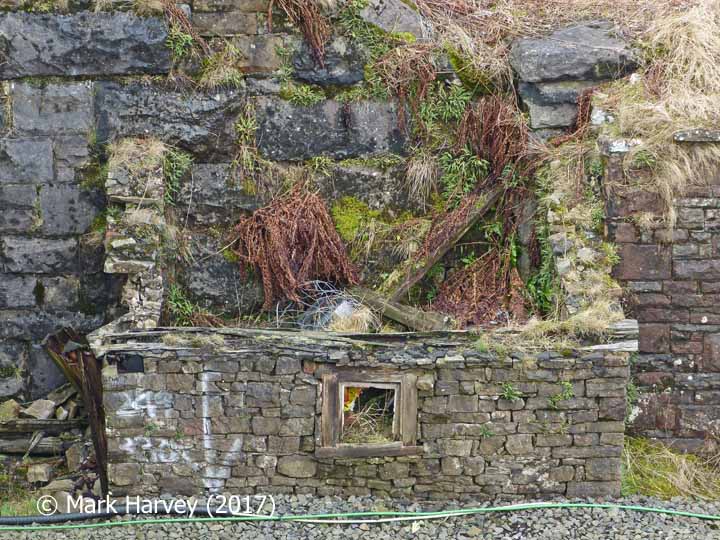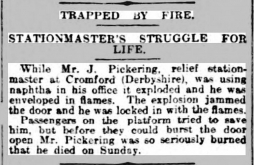
What were naphtha stores?
Naphtha is a form of crudely processed oil derived from hydrocarbons (typically coal, shale, peat or crude oil). It was used to fuel early designs of railway lanterns. Naphtha stores were small buildings constructed to store the Naphtha. They were probably also used to store the lamps (when not in use) and the tools and spare-parts needed for maintenance and repair. (See also 'lamp hut'.)
Why were 'naphtha stores' necessary?
Naphtha is volatile and highly flammable. It therefore needed to be stored in 'fireproof' / spark-proof buildings located well away from other important structures.
During the second half of the nineteenth century and the early twentieth century, naphtha was extensively used as a fuel for the oil lamps used by miners, tunnellers and railway workers (especially those working in railway tunnels).
The following extracts from published works shed some light (!) on the way that naphtha lamps were used (and misused):
- "For lighting the works of a Tunnel, candles will be found the best and cheapest means, where the work is cramped; each miner has one or two stuck in lumps of damp clay - he can move them about as he pleases, to throw light on his work. When the length gets opened out, naptha lamps can be used with advantage. Lighting will cost from 1½d. to 2d per cube yard excavated."
Source: Gripper, Charles F.: "Railway Tunnelling in Heavy Ground", published in London by E. & F. N. Spon (1879). -
"A man who worked for the Settle-Carlisle before the 1914-18 war recalled when the driver of a locomotive reported water pouring from a ventilation shaft in Blea Moor [tunnel]. Some of the 'garlands', or drainage channels, were blocked. 'We had to de-block them. We'd go to the top of the shaft, on the wild Blea Moor, and erect some scaffolding. Then we'd set up a jack-roll (hand-winch) and have a wire rope 120 yards long. It might take us a couple of days to do this. Three men held a handle of the jack-roll, and three men took hold of the other handle. The remaining man - often me! - had to go down the shaft to investigate and clean out the drains. I'd sit on a seat - it was just a piece of wood, fastened to the wire rope with a safety catch. A naphtha lamp was hung on the seat. A chap stationed down in the tunnel had a telephone and could talk to them stationed on t'moor. When I first looked down a shaft, I saw what appeared to be two little pencils far below; they were the rails. I was lowered to the first garland, which I cleared out; then to the second garland, and so on.'"
Source: Mitchell, W.R: "Life on the Settle-Carlisle Railway: anecdotes collected from railwaymen and their families", Dalesman (1984). Quoted here with the kind permission of Dr Mitchell. -
"Harry Cox, labouring in Blea Moor Tunnel prior to 1914, was fond of recalling his experiences. 'Naphtha lamps were used. If a man felt a little devilish he would accidentally knock one over, causing a spectacular blaze. If he felt even more devilish, he would throw something out of the darkness and knock over one or two lamps. Then the tunnel seemed to be on fire!'"
Source: Mitchell, W.R: "Men of the Settle-Carlisle - railwaymen talk to W.R. Mitchell", published by Dalesman (1985). Quoted here with the kind permission of Dr Mitchell.
The following newspaper article from 1914 suggests that naphtha lamps could be dangerous, even when being used normally.

Trapped by fire.
Stationmaster's struggle for life.
While Mr. J. Pickering, relief stationmaster at Cromford (Derbyshire), was using naphtha in his office it exploded and he was enveloped in flames. The explosion jammed the door and he was locked in with the flames.
Passengers on the platform tried to save him, but before they could burst the door open Mr. Pickering was so seriously burned that he died on Sunday.
Source: Gloucestershire Echo, 23rd February 1914. Clipping kindly supplied by Dave Harris, the Study Centre Co-ordinator for the Midland Railway Study Centre in Derby.
From the 1920s onwards, Britain's railway companies began to replace naphtha lamps with high pressure paraffin lamps (such as those manufactured by Tilley) as these were safer and less prone to blockages. However, the LM&SR plan for a proposed naphtha store at Monsal Dale (see below, left) suggests that naphtha continued to be used (probably in tunnels) until well after the grouping in 1923. The extracted text for the warning notice confirms the risky nature of naphtha and other petroleum-based products.
Notice to read
Naphtha & petroleum store. Highly Inflammable.
Caution:- Smoking, striking matches, or the use of lights
in or near this store is dangerous & is strictly forbidden.
By Order.Midland Railway Study Centre Reference 88 1971-384/342.
To view a larger version of the plan, click / tap on the thumbnail.
Further evidence of the risk posed by the use of naphtha under relatively normal working conditions is provided in the following Ministry of Transport accident report from 1931:
LONDON, MIDLAND AND SCOTTISH RAILWAY. SIR,
I have the honour to report for the information of the Minister of Transport, in accordance with the Order of the 2nd December, the result of my Inquiry into the circumstances attending the accident which occurred on the 2nd November, 1931, to W. Woodhouse at Buxworth on the London, Midland and Scottish Railway
On coming out of a tunnel at about 9.0 a.m., after examining the portion of his length which lay within it, Woodhouse, who is employed as a ganger, proceeded to re-fill his naphtha lamp. An underman, who had accompanied him in the tunnel and was about to re-enter it with the rest of the gang, had hung his lamp, which did not need filling, about two yards away without extinguishing it. The flame from this lamp set fire to some naphtha which Woodhouse happened to spill and his right hand was slightly burned in consequence.
There was no need for this lamp to have been left there in this instance, and Woodhouse would have been better advised had he had it either removed altogether or extinguished. In this respect 'he did not exercise that care which the use of these lamps requires, and a suitable instruction for the guidance of others drawing attention to the danger of naked lights when these lamps are being filled is for consideration.
Source: Railway Accidents: Reports by the Inspecting Officers of Railways of Inquiries Into Accidents" (Ministry of Transport, 1931), pages 21-22.
The paraffin lamps were, in turn, superseded by electric lighting after the Second World War (when mobile generators became available and as mains electricity was gradually rolled-out across the UK).
Naphtha Stores within the SCRCA
Within the SCRCA, there were at least three 'naphtha stores', namely:
- Structure 249210: Force Gill Aqueduct 'Naptha Store'
- Structure 254070: Rise Hill Tunnel south portal 'Naptha Store'
- Structure 295650: Baron Wood Tunnels 'Naptha Store'
Acknowledgements
Text by Mark R. Harvey (© Mark R. Harvey, 2017). Illustrations supplied by Mark R. Harvey and Dave Harris.

